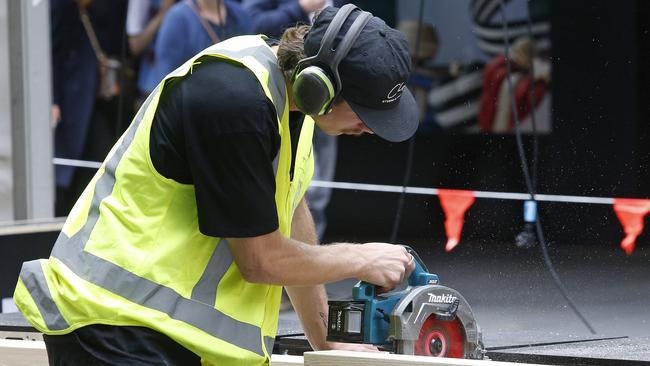Reserve Bank in no rush for rate cuts after employment surges by 56k
Labor can deliver low inflation and near-record low unemployment at the same time, Jim Chalmers declares, even as economists say new jobs data meant the Reserve Bank was in no rush to cut rates.

Labor can deliver low inflation and near-record low unemployment at the same time, Jim Chalmers has declared, even as economists said new jobs data meant the Reserve Bank was in no rush to cut interest rates in February.
More than 56,000 people found work in December, the Australian Bureau of Statistics said on Thursday, surging past expectations of a lift of 15,000, with the jobs jump wholly driven by gains in part-time employment.
That increase was not enough to keep the jobless rate from rising to 4 per cent last month, and up from 3.9 per cent in November, as the share of the working-age population in a job or searching for one returned to its record high of 67.1 per cent.
The Treasurer on Thursday lauded the figures as evidence Labor was on track to deliver a “soft landing”; that is, a return to inflation to the RBA’s 2-3 per cent target band without causing an economic downturn.
“If you look around the world, a lot of other countries have paid for progress on inflation with either recessions or negative quarters of growth or much higher unemployment,“ he said in Brisbane.
Dr Chalmers also weighed into the debate surrounding “full employment”, the maximum level of employment consistent with holding inflation within the RBA’s 2-3 per cent target band.
Economists call the lowest rate of unemployment that achieves this the “non-accelerating-inflation rate of unemployment”, or NAIRU.
Dr Chalmers said there was “a range of contested views” about the NAIRU level, suggesting it could be lower than Treasury or the RBA’s estimates, at 4.25 per cent and 4.5 per cent, respectively.
“If you look at the data and … what has been delivered in our economy, we see that we’ve had unemployment in the high threes and in the low fours for some time now at the same time as inflation has come from its peak … to within the Reserve Bank’s target band’” he said.
“What that tells us is that we can make this very substantial, very sustained progress on inflation at the same time as we maintain very low unemployment.”
With the jobs market remaining remarkably resilient by historical standards at the same time as wages and underlying inflation have eased, there is considerable conjecture that the NAIRU could be in fact much lower than previously thought.
Even if the NAIRU was lower, however, economists remained sceptical that there was an urgency for the RBA to deliver a quarter-percentage-point interest rate cut at its February 17-18 meeting, which would take the cash rate to 4.1 per cent.
RBC Capital Markets chief economist Su-Lin Ong said there was “no smoking gun” from the jobs figures that would prompt the RBA to cut interest rates next month.
“We read this as a very strong report with nothing here to suggest a labour market trigger for rate cuts,” she said, saying the much-anticipated December quarter inflation report, slated for release on January 29, would be key if a rate reduction was delivered.
The fresh data meant the jobless rate significantly undershot the RBA’s most recent staff forecasts. While they projected the unemployment rate would average 4.3 per cent across the December quarter, it was just 4 per cent across that period.
Reacting to the bumper jobs report, bond traders scaled back their rate cut bets, tipping a 66 per cent chance of a quarter-percentage-point rate cutin February, down from a near-75 per cent chance prior to the release.
Markets remained fully priced for the RBA’s subsequent meeting, scheduled for March 30-April 1.
Ahead of the impending federal election, which must be held on or before May 17, an interest rate cut would help bolster the Albanese government’s standing among household borrowers who have weathered 13 rate hikes since May 2022.
Failing a cut in February, the RBA’s April meeting – where the RBA’s new specialist rate-setting board will convene for the first time – is the only other opportunity for pre-election interest rate relief.
While the RBA forecasts the jobless rate to rise to 4.5 per cent by the end of 2025, NAB senior economist Taylor Nugent said the central bank would need to be alive to the risk that the weakening of the jobs market may have stalled, or even begun to reverse.
“There is value in waiting to get a better handle on the trajectory of growth and the labour market given the broader macro backdrop does not create any urgency to cut rates,” Mr Nugent said.
Further indicating the strength in the jobs market was the underemployment rate – a measure of those in work but looking for additional hours – which ticked lower to 6 per cent, and down from 6.1 per cent in November.
But with December’s jobs gains solely driven by an 80,000 increase in the number of part-time employees, compared with a full-time employment loss of 23,700 people, KPMG chief economist Brendan Rynne argued there were signs of weakness in the job market.
“The impressive headline figures in today’s employment data may give a misleading impression,” Dr Rynne said. “The reduction in full-time employment provides some impetus for the bank to consider a cut in the cash rate sooner rather than later.”




To join the conversation, please log in. Don't have an account? Register
Join the conversation, you are commenting as Logout